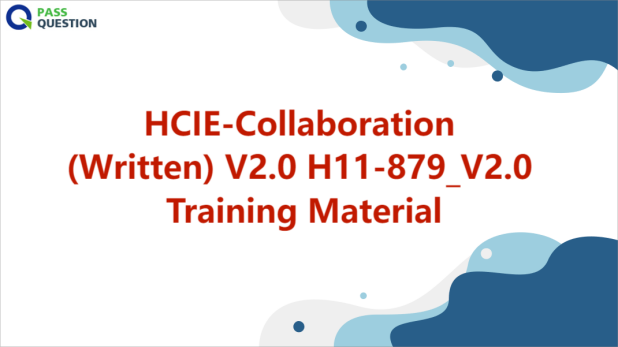HCIE-Collaboration (Written) V2.0 H11-879_V2.0 Training Material
To ensure that you are fully equipped to excel in the H11-879_V2.0 HCIE-Collaboration (Written) V2.0 exam, we highly recommend studying the most up-to-date HCIE-Collaboration (Written) V2.0 H11-879_V2.0 Training Material from PassQuestion. This comprehensive resource will not only provide you with the necessary knowledge to pass your exam with ease, but it will also enhance your understanding of the subject matter, enabling you to confidently tackle any question that may arise during the examination. By investing time and effort into studying this HCIE-Collaboration (Written) V2.0 H11-879_V2.0 Training Material, you will significantly increase your chances of achieving a favorable outcome in your H11-879_V2.0 HCIE-Collaboration (Written) V2.0 exam.

HCIE-Collaboration (Written) Certification
Passing the HCIE-Collaboration V2.0 certification proves that you have systematically understood and mastered the technical principles of audio and video technologies, H.323 and SIP protocols, high-reliability solution, public-private network traversal solution, convergence solution, system networking planning and design, system O&M, and troubleshooting in the collaboration field, and are capable of network planning, design, O&M, and troubleshooting of Huawei video conferencing systems.
HCIE-Collaboration (Written) V2.0 Exam Overview
Exam Name: HCIE-Collaboration (Written)
Exam Code: H11-879
Exam language: ENU/CHS
Question Type: Single Answer, Multiple Answer, True-false Question, Fill in the blank answers, Drag and drop item
Exam fees: 300USD
Exam Duration: 90min
Passing score/Total score: 600/1000
HCIE-Collaboration (Written) V2.0 Exam Content
Intelligent Collaboration Solution Overview 5%
Principles of Audio Technology 7%
Principles of Video Technology 8%
SIP Principles 18%
H.323 Protocol Principles 13%
Public-Private Network Traversal Solution 11%
Convergence Solution for the Video Conferencing System 6%
Reliability Solution for the Video Conferencing System 11%
Networking Planning and Design of the Video Conferencing System 5%
Video Conferencing System O&M 8%
Video Conferencing System Troubleshooting 8%
View Online HCIE-Collaboration (Written) V2.0 H11-879_V2.0 Free Questions
1. What is the core reason why video conferencing supports public and private network traversal?
A. There is a firewall or NAT, so public and private network traversal must be supported.
B. Signaling and media transmission channels are not unified
C. There is a media transmission address in the signaling, and the NAT device only performs address translation on the IP header, so public and private network traversal processing is required.
D. Because the network performs address translation on IP packets
Answer: C
2. In video conferencing, which anti-packet loss method will not increase network bandwidth?
A. ARQ packet loss retransmission
B. FEC forward error correction
C. Packet loss compensation PLC
D. Redundant coding
Answer: C
3. Which of the following descriptions about HD terminals is correct?
A. HD video terminals cannot communicate with SD video terminals
B. HD video terminals must be registered to GK to communicate
C. The high-definition video terminal supports remote control of the camera
D. The password for the HD video terminal WEB page cannot be empty.
Answer: C
4. Which statement is correct about Huawei's video network recording and broadcasting solution?
A. Only the SMC interface and telepresence central control interface can control recording and playback.
B. The terminal recording and broadcasting request will be sent to the MCU, and then the MCU will perform unified recording and broadcasting operations.
C. When the meeting ends, the recording server will return the recording address to SMC, and SMC will notify the user via email to watch on-demand.
D. Support point-to-point recording and local recording
Answer: C
5. Which of the following is the core reason why a video conferencing system requires a public-private network traversal function?
A. The IP header of the private network device needs to be address translated.
B. The signaling and media transmission channels are not unified.
C. There is a media transmission address in the signaling, but the NAT device only performs address translation on the IP header.
D. Because the network performs address translation on IP packets.
Answer: C
6. Among the following application modes, () video conferencing has the highest interactivity requirements.
A. Peer-to-peer mode
B. Small-capacity multi-point conference
C. Large-capacity multi-point conference
D. Cascading conference
Answer:A
7. If the SMC conference administrator does not enable conference recording when booking a meeting, which of the following operations can he use to enable recording during the meeting?
A. Enter the conference control interface>Details>Recording to start recording.
B. Notify the SMC system administrator to perform the following operations: Device management recording server > Start recording
C. Enter the conference control interface>More>Recording to start recording
D. Unable to start recording
Answer: C
8. The video system is a value-added service based on the communication network that integrates multiple media processing, including () media communication.
A. Message communication
B. Audio communication
C. Video communication
D. Data communications
Answer: BCD
- TOP 50 Exam Questions
-
Exam
All copyrights reserved 2025 PassQuestion NETWORK CO.,LIMITED. All Rights Reserved.

